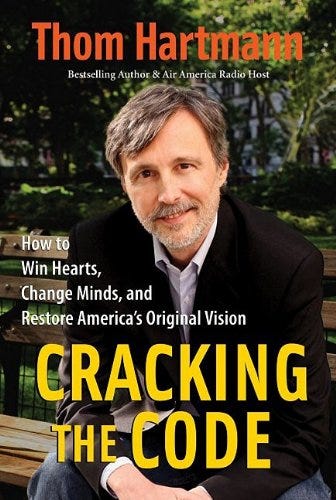Sunday Excerpt - "Cracking The Code: How to Win Hearts, Change Minds, and Restore America's Original Vision "
I published this book in 2008 to help Democrats with messaging, but it applies to just about every aspect of life...
Introduction: Talking the Talk
My wife, Louise, and I live atop 30 feet of water, 100 feet from shore, in a floating home on a river in Portland, Oregon. One day I stepped out our back door onto the floating deck that serves as our backyard and found myself confronting a very upset Canada goose. He bobbed his head up and down, lifted his wings to make his body look larger and more intimidating, and ran straight at me, hissing and trying to nip at me.
Observing this behavior, my comedian friend Swami Beyondananda (Steve Bhaerman), who was visiting us that week, named the bird Goosalini.
I had no idea why this psycho goose was attacking, but there was no mistaking what Goosalini was trying to communicate: Stay inside that house and don’t come out! I got the message, but I didn’t stay inside. Instead, every time I went out to water the plants on my deck, I brought a broom with me to fight off Goosalini.
I found out what was going on a week later, when I learned from my neighbor that a female goose had settled on her back deck, just a few feet from our own, and was sitting on a nest. I realized that Goosalini must have been the proud papa, protecting his territory, and I stopped swatting at him with my broom.
Goosalini has a lot to tell us about communicative strategies. Even though he was just doing what a gander does when he wants a predator to leave—draw attention to himself and away from his mate, attack first and ask questions later—he was able to communicate the “go away” part of his message to me pretty well. We all communicate all the time, even when we don’t give much thought to what we are saying or how we are saying it.
Because Goosalini was unable to use what we would call rational powers of persuasion, he communicated by going straight for the more primitive parts of my brain—the parts we shared as human and goose, the center of our gut feelings. The first time Goosalini attacked, I backed off because he was successful in communicating an intent to harm me, which caused me to feel fear, that most primal and visceral of human emotions.
The first key to unlocking the communication code is to understand that when we communicate, feeling comes first. Emotions will always trump intellect, at least in the short term.
This emotive form of communication, however, ultimately didn’t get Goosalini the response he wanted. On its own the attack wasn’t very persuasive. Instead of shooing me away, Goosalini got me angry.
Effective communicators know how to get the response they want because they understand how to tailor a message to the person who’s listening. They know the second key to unlocking the communication code: the meaning of a communication is the response you get.
Because Goosalini couldn’t tell me his story, I had to imagine his story for myself. The first story I came up with was that he was simply a psycho goose, trying to hurt me for no reason I could understand. The second story that I came up with—after talking to my neighbor—was a story of a dad protecting his soon-to-be-hatched goslings. Both stories accurately described what was happening, but the stories led to very different endings. The psycho goose made me angry; the dad goose made me feel protective of Goosalini himself.
In this book I call such stories “maps,” and the world the stories describe as “the territory.” The third key to unlocking the communication code is: the map is not the territory. Each story captures a different piece of reality; no one story captures all of it. The key to effective communication is to find



